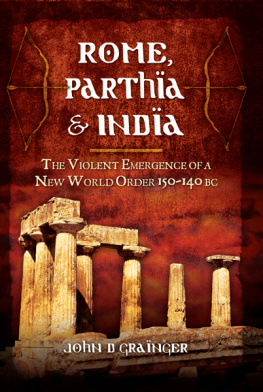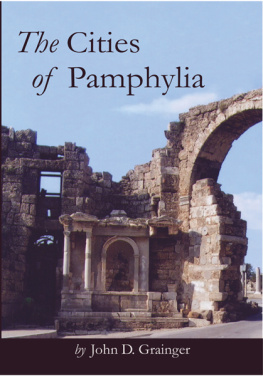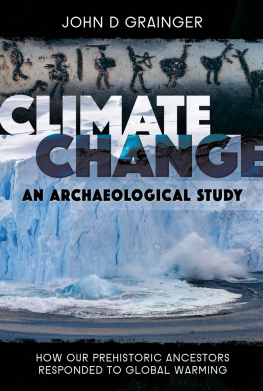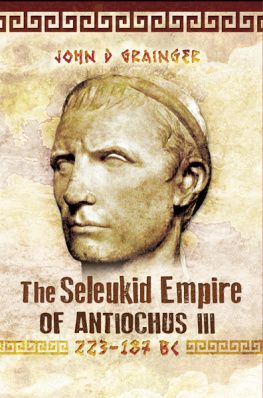First published in Great Britain in 2013 by
The Praetorian Press
an imprint of
Pen & Sword Books Ltd
47 Church Street
Barnsley
South Yorkshire
S70 2AS
Copyright John D. Grainger 2013
HARDBACK ISBN: 978 1 84884 825 2
PDF ISBN: 978 1 47383 129 2
EPUB ISBN: 978 1 47383 013 4
PRC ISBN: 978 1 47383 071 4
The right of John D. Grainger to be identified as the Author of this
Work has been asserted by him in accordance with the Copyright,
Designs and Patents Act 1988.
A CIP catalogue record for this book is available from the British
Library
All rights reserved. No part of this book may be reproduced or
transmitted in any form or by any means, electronic or mechanical
including photocopying, recording or by any information storage and
retrieval system, without permission from the Publisher in writing.
Typeset in Ehrhardt by
Mac Style, Driffield, East Yorkshire
Printed and bound in the UK by CPI Group (UK) Ltd, Croydon,
CRO 4YY
Pen & Sword Books Ltd incorporates the Imprints of Pen & Sword
Aviation, Pen & Sword Maritime, Pen & Sword Military, Wharncliffe
Local History, Pen and Sword Select, Pen & Sword Military Classics,
Leo Cooper, The Praetorian Press, Remember When, Seaforth
Publishing and Frontline Publishing.
For a complete list of Pen & Sword titles please contact
PEN & SWORD BOOKS LIMITED
47 Church Street, Barnsley, South Yorkshire, S70 2AS, England
E-mail:
Website: www.pen-and-sword.co.uk
Contents
Maps
Table
Maps
Introduction
I n 1989 the President George Bush I proclaimed the emergence of a New World Order, which had resulted from the collapse of the Soviet Union this being the term which is the current phrase in Russia for these events. There is certainly a New World system emerging, though there seems for the moment little order in it, and it is nowhere near what Bush expected. But if he had been better versed in history the president would have known that this was scarcely the first of these sudden changes. They are usually in preparation for a generation or two, and when the change occurs it takes only a few years to happen. The result is a visible change in affairs, above all in international political alignments. So relatively lengthy periods of little change are followed by brief periods when the tensions developed in that time of peace are released and a new problem confirmed. The word earthquake seems appropriate.
This pattern of relative placidity for a relatively lengthy period followed by a paroxysm of change, which is then followed by another period of relative placidity, is the result of a political system in which several, or many, states co-exist and compete. Europe for the past millennium is one such time and place. The periods of relative calm placidity is perhaps not the most accurate description are not necessarily untroubled, but any troubles which occur are only local, or are confined to a particular part of the system. In terms of Europe since the eighteenth century, there was a placid period between 1748 and 1792, and it was the French Revolution and the violent career of Napoleon Bonaparte, between 1792 and 1815, which was the paroxysm of change. This was followed by a period of calm until the 1860s, when Prussias three victorious wars shook much of the old system. In the calm period of 18151864, there were certainly difficulties and changes in the Netherlands, in Greece, in Spain, revolutions in France, the unification of Italy in awkward stages, the great revolutionary upheaval of 1848, rebellions against the Russians in Poland, the Crimean War but the system as it was in 1864 was recognizably very similar to that in 1815; indeed the German wars between 1864 and 1871 may also be seen as another relatively minor and local difficulty, and the system as it was in 1914 could be seen in that of 1815.
But the Great War was clearly a paroxysm of change just as was that of 17921815, and this was repeated in 19381945. One must conclude that the long periods of relative calm allowed tensions to develop which could only be relieved by a paroxysm of warfare. The smaller changes in European affairs between 1815 and 1914 had not been enough to relieve that pressure.
The ancient Mediterranean and Middle Eastern world exhibits the same alternation of lengthy calm and sudden change. Things moved more slowly than in modern Europe, and such changes were less frequent, but the pattern is there. Taking in the whole civilized world from India to Spain, as this book does, the first of these paroxysms was probably the destruction of the Assyrian Empire in the late seventh century BC. A period of international tension between a set of great powers followed from about 600 BC, then the rapid creation of the Persian Empire between 546 and 522 is the next paroxysm of change. The Akhaimenid Empire was a long period of imperial peace which contained within it, like nineteenth century Europe, a series of local problems and disturbances which did not essentially disturb the whole: repeated rebellions in Egypt, the Greek wars, campaigns in Central Asia, rebellions by Persian aristocrats, coups dtat at the centre. But in 340 BC the situation was much as it had been in, say, 520 BC. And yet strains were clearly developing around the edges of the imperial system, in Macedon, in Greece, in Egypt, further afield in Italy 342340 is the crucial moment in the emergence of the Roman system and in India with the expansion of the Magadha state as well.
Alexanders campaign and the Macedonian civil wars which followed (334301) is another of the periods of sudden change, which was followed by the relative calm and minor changes of the Hellenistic period again the calm clearly does not exclude wars and changes, but they tended to be local. This book considers a fourth of these ancient world seismic periods, between 150 and 140 BC. This was when the Roman Republic suddenly emerged, after six decades of refusal to expand, as an empire controlling the Mediterranean world from the Aegean to Spain and Africa; simultaneously in the lands from Babylonia to India the small Parthian state swiftly grew into an empire stretching from the Euphrates to Central Asia; in India the tentative revival of the Maurya empire failed, but in Central Asia the Greek Baktrian state collapsed.
The significance of this period of change is that these developments laid the outline for the political world order for the next seven-and-a-half centuries, in which the central confrontation, around which everything else revolved, was that between the several Roman Empires Republic, Principate, Dominate, Byzantium and the successive Iranian empires of Parthia and the Sassanids. Beside this constant conflict the inclusion of the West in the Roman state and the events in Central Asia and India were of only secondary importance. India was involved in western affairs because of Alexander, but became shut out once the Parthians interposed themselves between Syria and India; the western Mediterranean regions were included in Romes empire, but affairs west and north of Italy were scarcely of the same importance as those which took place between Antioch and Babylon. Beside the confrontation in Mesopotamia, the loss of Spain and Gaul, even of Italy, was secondary.
Of course the situation of affairs as it was in 140 BC was as yet only a broad sketch of that which became fully formed by 50 BC. Yet the outline was clear: by 140 Rome and Parthia were the two great powers, and from 140 to 50 the only real question was where the line of division between them would finally be drawn.
The central event in this brief set of changes is the collapse of the Seleukid kingdom. It is this which opened the way for the expansion of the Parthian state, and its reduction to weakness also weakened the whole international political system, in Egypt, Asia Minor, Central Asia, and the western Mediterranean. The rise of Rome and Parthia to their dominating Great Power positions, which they clearly occupied from 140 onwards, was largely the result of the Seleukid collapse.
Next page













